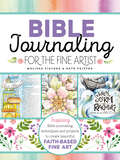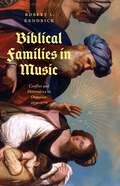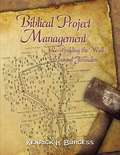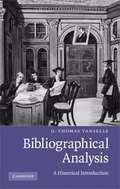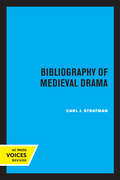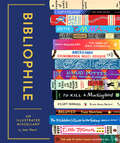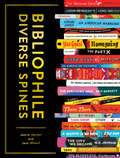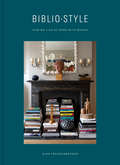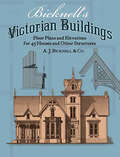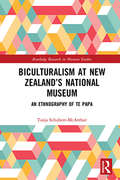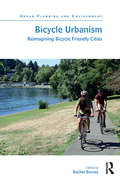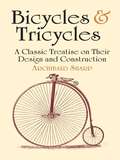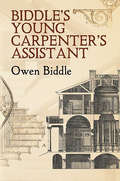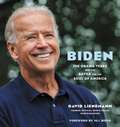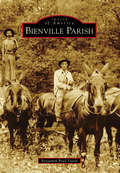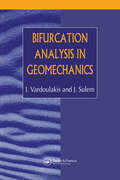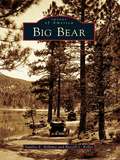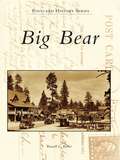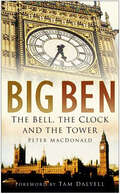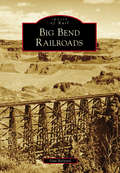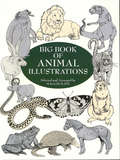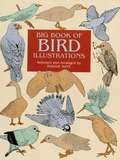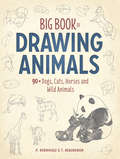- Table View
- List View
Bible Journaling for the Fine Artist: Inspiring Bible Journaling Techniques and Projects to Create Beautiful Faith-Based Fine Art
by Melissa Fischer Kate PeifferDrawing, painting, and journaling activities that use the Christian bible as a starting point for inspiration and exploration of faith.Explore your faith artistically with Bible Journaling for the Fine Artist—a guide that goes beyond doodling and lettering to teach you to make fine art prayer journals, daily devotionals, and more.Beginning with a brief introduction to Bible journaling, this valuable guide explores various media, including colored pencils, pen and ink, brush pens, and watercolor paint, and how to use them. You will find dozens of step-by-step tutorials for drawing and painting beautiful artwork related to meaningful Bible passages, as well as plenty of ideas and techniques for applying lettering, flourishes, icons, and embellishments to your artwork for maximum impact.There are tips for creating compelling layouts, reworking and embracing mistakes, and several step-by-step projects for you to incorporate into your own Bible or prayer journal. Two talented and dynamic artists, Melissa Fischer and Kate Peiffer, show how they integrate their own style and artistry with their faith through a variety of art journaling projects, from full-page masterpieces to smaller artwork in the margins and on the covers of their journals.From simple doodled designs to elaborate full-page artwork, creating in the pages of your Bible is a beautiful and meaningful way to express and explore your faith. With just a few art tools of your choosing, you can turn the pages of your Bible into personal and special works of art that reflect your God-given creativity and your relationship with Him.
Biblical Families in Music: Conflict and Heterodoxy in Oratorios, 1670–1770
by Robert L. KendrickExamines how stories of biblical families were reconfigured and projected in the genre of the oratorio, a form of sacred opera, in the seventeenth and eighteenth centuries. Based to a great extent on the Old Testament, the largely Catholic musical-dramatic genre was popular in Italy, Austria, and southern Germany in the seventeenth and eighteenth centuries. Biblical Families in Music reveals how difficult stories of fratricide, child sacrifice, death, and forbidden love performed a didactic function in oratorios, teaching early modern audiences about piety and the rules of proper family life. In the century after 1670, the heavily adapted tales of Abraham and Isaac, Cain and Abel, and the Egyptian slave Hagar and her son Ishmael were set to music by figures such as Alessandro Scarlatti and Antonio Sacchini and performed during Lent in churches and other sacred spaces for an audience of court nobility, clergy, and the urban patriciate. By examining the resonance of Catholic oratorios within predominantly upper-class social realities, the book broadens our cultural understanding of the early modern European family and underscores the centrality of family and familial relation to social position, devotional taste, and identity.
Biblical Project Management: Re-Building the Wall Around Jerusalem
by Kenrick H. BurgessThis book is about biblical project management, principles, tools, techniques, and practices used by Nehemiah, a cupbearer to the King of the Persian Empire in the re-building of the wall around Jerusalem and its revitalization. It can be used as a manual for project recovery by project sponsors, owners, leaders, project managers and teams managing projects.The book has three parts:Part One deals with the characteristics and definitions of a project and biblical project management, the roles of a project manager, and the importance of stewardship in project management. There is also a brief overview of the Bible, its inspired writers, its impact, legal, financial, and project management systems.Part Two examines Nehemiah&’s project recovery management methodology, and his incredible use of advanced project management tools and techniques are demonstrated by referring to the approaches that he used to re-build the wall and achieve spiritual revival in Jerusalem.The reader will learn:about Jerusalem in the time of Nehemiahhow to prepare a project background and project definition reporthow to make successful interventions and to present the case for the recovery of a project to owners, sponsors, politicians and public officialshow to conduct a detailed assessment of a troubled projecthow to do project reviews and document the variances in the scope of works, objectives, milestones, resources, quality, risks and expected deliverables, and to decide on the way forwardabout the capabilities required by the project manager to rescue projects such as courage; leadership; project management skills; technical competencies; project knowledge and understanding; wisdom; solving disputes; assessing the actual scope of works required; and evaluating the cultural, political, economic, social, environmental, and technical issueswhat to include in a final assessment reporthow to prepare the work breakdown structure, precedence network diagram; milestone plan, responsibility matrix, project organization, risk management planhow to develop the fifteen plans necessary for construction and control planningteamwork strategies, networking, project oversight, monitoring, tracking, construction management, stakeholders&’ management and analyses, reasons why projects fail, the role of a project champion, and critical success factors for rescuing troubled projectsNehemiah&’s project recovery management methodologyhow to revitalize and bring spiritual revival to a cityhow to conduct an ex-post evaluation of a project, andhow to dedicate a project.Part Three discusses a) the significance-driven project manager; b) leadership; c) the significance of the walls, towers and gates around Jerusalem; d) how to follow the footsteps of Nehemiah, and e) power tools and power required for project managers.
BiblioCraft: A Modern Crafter's Guide to Using Library Resources to Jumpstart Creative Projects
by Jessica PigzaUncover a treasure-trove of crafting tips and inspiration with help from a rare book librarian and examples from Natalie Chanin, Liesl Gibson, and more. A Library Journal Best Book of the Year Deep in the stacks of any library is a wealth of inspiration waiting to be uncovered, and a plethora of projects ready to be tackled. In BiblioCraft, crafting aficionado and rare book librarian Jessica Pigza shares her secrets to scouring those musty collections—both in person and online—for everything from vintage needlepoint magazines to historic watermarks and Japanese family crests. As a host of the New York Public Library&’s Handmade Crafternoon series, Pigza has helped creative people of all types take advantage of these hidden riches. BiblioCraft also presents more than twenty projects inspired by library resources from a stellar cast of designers, including Alabama Chanin founder Natalie Chanin, Liesl + Co. founder Liesl Gibson, Charm Patterns founder Gretchen Hirsch, illustrator and fabric designer Heather Ross, Design*Sponge founder Grace Bonney, and others. Whether your passion is pillows or coasters, fascinators or fabrics, Pigza will show you how to turn your local library into a global crafting goldmine.
Bibliographical Analysis
by G. Thomas TanselleStudying printed books as physical objects can reveal not only how books were produced, but also how their design and layout features emerged and came to convey meanings. This concise and accessible introduction to analytical bibliography in its historical context explains in clear, non-specialist language how to find and analyze clues about a book's manufacture and how to examine the significance of a book's design. Written by one of the most eminent bibliographical and textual scholars working today, the book is both a practical guide to bibliographical research and a history of bibliography as a developing field of study. For all who use books, this is an ideal starting point for learning how to read the object along with the words.
Bibliography of Medieval Drama
by Carl J. StratmanThis title is part of UC Press's Voices Revived program, which commemorates University of California Press’s mission to seek out and cultivate the brightest minds and give them voice, reach, and impact. Drawing on a backlist dating to 1893, Voices Revived makes high-quality, peer-reviewed scholarship accessible once again using print-on-demand technology. This title was originally published in 1954.
Bibliophile: An Illustrated Miscellany (Bibliophile Ser.)
by Jane MountPerfect gift for book lovers, writers and your book clubBook lovers rejoice! In this love letter to all things bookish, Jane Mount brings literary people, places, and things to life through her signature and vibrant illustrations.Readers of Jane Mount's Bibliophile will delight in:Touring the world's most beautiful bookstoresTesting their knowledge of the written word with quizzesFinding their next great read in lovingly curated stacks of booksSampling the most famous fictional mealsPeeking inside the workspaces of their favorite authorsA source of endless inspiration, literary facts and recommendations: Bibliophile is pure bookish joy and sure to enchant book clubbers, English majors, poetry devotees, aspiring writers, and any and all who identify as book lovers.If you have read or own: I’d Rather Be Reading: The Delights and Dilemmas of the Reading Life; The Written World: The Power of Stories to Shape People, History, and Civilization; or How to Read Literature Like a Professor: A Lively and Entertaining Guide to Reading Between the Lines; then you will want to read and own Jane Mount's Bibliophile.
Bibliophile: Diverse Spines
by Jane Mount Jamise HarperIt's time to diversify your reading list.This richly illustrated and vastly inclusive collection uplifts the works of authors who are often underrepresented in the literary world. Using their keen knowledge and deep love for all things literary, coauthors Jamise Harper (founder of the Diverse Spines book community) and Jane Mount (author of Bibliophile) collaborated to create an essential volume filled with treasures for every reader:• Dozens of themed illustrated book stacks—like Classics, Contemporary Fiction, Mysteries, Cookbooks, and more—all with an emphasis on authors of color and own voices• A look inside beloved bookstores owned by Black, Indigenous, and People of Color• Reading recommendations from leading BIPOC literary influencersDiversify your reading list to expand your world and shift your perspective. Kickstart your next literary adventure now!EASY TO GIFT: This portable guide is packed with more than 150 colorful illustrations is a perfect gift for any booklover. The textured paper cover, gold foil, and ribbon marker make this book a special gift or self-purchase.DISCOVER UNSUNG LITERARY HEROES: The authors dive deep into a wide variety of genres, such as Contemporary Fiction, Classics, Young Adult, Sci-Fi, and more to bring the works of authors of color to the fore.ENDLESS READING INSPIRATION: Themed book stacks and reading suggestions from luminaries of the literary world provide curated book recommendations. Your to-read list will thank you.Perfect for: bookish people; literary lovers; book club members; Mother's Day shoppers; stocking stuffers; followers of #DiverseSpines; Jane Mount and Ideal Bookshelf fans; Reese's Book Club and Oprah's Book Club followers; people who use Goodreads.com; readers wanting to expand/decolonize their book collections; people interested in uplifting BIPOC voices; antiracist activists and educators; grads and students; librarians and library patrons wanting to expand/decolonize their book collections; people interested in uplifting BIPOC voices; antiracist activists and educators; grads and students; librarians and library patrons
Bibliostyle: How We Live at Home with Books
by Nina Freudenberger Sadie SteinA visual delight and an inspiration for every bibliophile with a growing home library, this dream-and-drool design book features some of the most jaw-dropping book collections of homeowners around the world.Interior designer Nina Freudenberger, New Yorker writer Sadie Stein, and Architectural Digest photographer Shade Degges give readers a peek at the private libraries and bookshelves of passionate readers all over the world, including Larry McMurtry, Silvia Whitman of Shakespeare and Co., Gay and Nan Talese, and Emma Straub. Throughout, gorgeous photographs of rooms with rare collections, floor-to-ceiling shelves, and stacks upon stacks of books inspire readers to live better with their own collections.
Bicknell's Victorian Buildings: Floor Plans and Elevations for 45 Houses and Other Structures
by A. J. BicknellBy the 1880's, American architecture had turned to a heavily formal, almost grandiose style, forsaking the more delicate ornamentation and graceful line of the previous decade. Just prior to the shift, A. J. Bicknell & Co. published a handsome volume of contemporary designs, plans and specifications for a wide range of public and private buildings from many parts of America. Their intention was to feature a complete village which could be constructed at moderate cost; in fact they published one of the last inclusive documentations of that style of mixed Gothic, Romanesque and classical cornices, pedestals, spires and gables known as "Victorian."Forty-five buildings of all sorts -- cottages, villas, suburban houses, town houses, a farm, a jail, courthouses, banks, store fronts, churches, schools, even stables -- are portrayed in beautiful architectural drawings of scaled elevations and floor plans. Large-sized details show the principal corners, panels, railings, arches, finials, window and verandah sections; scales range from 3/32 of an inch to the foot for the elevations, to 1/2"/1' for the details.The designs come from architects in Boston, Philadelphia, Chicago, St. Louis, Nashville, and were built in many large and small communities. Along with the private homes and standard public buildings, there are plans for the first completely fireproof courthouse (built of marble and cast iron) in the United States, at Macoupin County, Illinois; the Bay County Courthouse in Bay City, Michigan, may also be numbered among the noteworthy inclusions. A three-story home in this book, with four bedrooms, dining room, kitchen, parlor, verandah, hall, portico, and cellar (with servants' quarters, if necessary) cost, at that time, $5000 to build; a series of specifications, both general and particular (for carpenters, plumbers, painters and masons) and sample contracts (with provisions for bad weather and striking workmen) offer some idea how such buildings were possible at such prices.The detailed measurements and specifications provide modellers, miniaturists, set designers, woodworkers, or even full-scale builders, with the information necessary to recreate these designs. Historians of architecture, home restorers, anyone who delights in the felicities of American Victorian, will find this book a superb primary source of authentic building style.
Biculturalism at New Zealand’s National Museum: An Ethnography of Te Papa (Routledge Research in Museum Studies)
by Tanja Schubert-McArthurThe Museum of New Zealand Te Papa Tongarewa has been celebrated as an international leader for its bicultural concept and partnership with Māori in all aspects of the museum, but how does this relationship with the indigenous partner work in practice? Biculturalism at New Zealand’s National Museum reveals the challenges, benefits and politics of implementing a bicultural framework in everyday museum practice. Providing an analysis of the voices of museum employees, the book reflects their multifaceted understandings of biculturalism and collaboration. Based on a year of intensive fieldwork behind the scenes at New Zealand’s national museum and drawing on 68 interviews and participant observations with 18 different teams across the organisation, this book examines the interactions and cultural clashes between Māori and non-Māori museum professionals in their day-to-day work. Documenting and analysing contemporary museum practices, this account explores how biculturalism is enacted, negotiated, practised and envisioned on different stages within the complex social institution that is the museum. Lessons learnt from Te Papa will be valuable for other museums, NGOs, the public service and organisations facing similar issues around the world. Biculturalism at New Zealand’s National Museum addresses a gap in the literature on biculturalism and reaffirms the importance of ethnography to the anthropological enterprise and museum studies research. As such, it will be essential reading for academics, researchers and postgraduate students in the fields of cultural anthropology, museum anthropology, museum studies, and Māori studies or indigenous studies. It should also be of great interest to museum professionals.
Bicycle Urbanism: Reimagining Bicycle Friendly Cities (Urban Planning and Environment)
by Rachel BerneyOver recent decades, bicycling has received renewed interest as a means of improving transportation through crowded cities, improving personal health, and reducing environmental impacts associated with travel. Much of the discussion surrounding cycling has focused on bicycle facility design—how to best repurpose road infrastructure to accommodate bicycling. While part of the discussion has touched on culture, such as how to make bicycling a larger part of daily life, city design and planning have been sorely missing from consideration. Whilst interdisciplinary in its scope, this book takes a primarily planning approach to examining active transportation, and especially bicycling, in urban areas. The volume examines the land use aspects of the city—not just the streetscape. Illustrated using a range of case studies from the USA, Canada, and Australia, the volume provides a comprehensive overview of key topics of concern around cycling in the city including: imagining the future of bicycle-friendly cities; integrating bicycling into urban planning and design; the effects of bike use on health and environment; policies for developing bicycle infrastructure and programs; best practices in bicycle facility design and implementation; advances in technology, and economic contributions.
Bicycles & Tricycles: A Classic Treatise on Their Design and Construction (Dover Transportation)
by Archibald SharpUp until the publication of this book in 1896, no comparable work existed on the science, design, and mechanics of the bicycle -- an invention that revolutionized transportation for the average person and had far-reaching social and economic consequences. While other books on the bicycle have been written since, this late-19th-century classic remains unsurpassed in the thorough, accurate, and highly accessible coverage of every aspect of bicycle design and construction. Over 560 illustrations, diagrams, figures, and tables complement an exhaustive examination of such topics as the development of cycles, kinematics, stability, steering, the frame, gears, stresses, mechanical components, and much more. A marvel of scientific exposition for its time, this fascinating treatise will attract a wide audience of readers interested in technology and invention as well as serious and competitive cyclists, bicycle designers, and collectors.
Biddle's Young Carpenter's Assistant: Being A Complete System Of Architecture For Carpenters, Joiners, And Workmen In General, Adapted To The Style Of Building In The United States; Revised And Corrected, With Several (Dover Architecture)
by Owen BiddlePhiladelphia-based builder Owen Biddle was a major influence on later architects, thanks to this well-illustrated and much studied guide. One of the very first manuals of American architecture, this essential sourcebook offers authentic views of interior and exterior designs of buildings erected in the decades following the American Revolution.Reproduced from a rare 1805 edition, this handsome volume features 135 drawings. Its text and illustrated details depict typical building materials, styles, architectural ornamentation, and interior designs. A fascinating look at how public structures and private homes were designed, contracted, built, and embellished during the Federal period, this work is an essential reference for students, professionals, and all aficionados of architectural history.
Biden: The Obama Years and the Battle for the Soul of America
by David LienemannThe visual chronicle of Joe Biden's eight years as vice president to Barack Obama, revealing in intimate detail who the presumptive 2020 Democratic nominee is as a leader, father, friend, and future President This book captures the core of who Joe Biden is as a lifelong public servant, and who he would be as America's next President--featuring photographs from his eight years as one of America's most consequential vice presidents and partner to Barack Obama. These visually arresting photographs and behind-the-scenes stories show Biden stepping into his own as a leader ready to guide a nation in distress. They also reveal a new dimension to Biden's humanity--as a man whose decency and kindness shines through both tragedy and triumph, whose working-class roots inform his values, and whose candor and approachability enable him to connect with citizens of all kinds. This book traces Biden's vice presidency in unprecedented detail, shedding light on who he is as a political leader and patriot, and also as a father, husband, and friend. It will delight and fascinate readers who yearn for the return of honesty and ethics to the nation's highest offices. As we draw closer to the 2020 presidential elections, this portrait of one of the most influential names in American politics is more timely and important than ever.
Bienville Parish (Images of America)
by Benjamin Brad DisonBienville Parish, founded in 1848, is located in central north Louisiana. While perhaps most well-known for its ties to outlaws Bonnie and Clyde, Bienville Parish has a rich timber and railroad history that has shaped the community for over a century. Settlers moved into the region to take advantage of its flourishing industry, but it was community that led people to put down roots in the area. Religion and education formed the basis of everyday life in the rural region. In this photographic history, Bienville Parish is depicted through the lives of the people who inhabited the area. Although its size has decreased in recent years, the people who still reside in the parish have made it a priority to preserve the memories for future generations.
Bifurcation Analysis in Geomechanics
by J. Sulem I.G. VardoulakisThis book examines the experimental and theoretical aspects of bifurcation analysis as applied to geomechanics. Coverage includes basic continuum mechanics for dry and fluid unfiltrated porous media, bifurcation and stability analyses applied to layered geological media and granular materials, and theories for generalized continua as applied to materals.
Big Appetites: Tiny People in a World of Big Food
by Christopher BoffoliWelcome to a world where little people have big personalities. A world that’s upside down and yet weirdly, wonderfully real. A world where Lilliputian thieves poach strawberry seeds. Where it takes a guy with a jackhammer to pop open pistachios. Where skaters fall into a crack in the crème brûlée, and teddy bear cookies congregate with evil intent.Marrying inspired photographs of real food and tiny people with equally inspired captions, photographer Christopher Boffoli creates a smart, funny, quirky vision of what it means to play with your food. The scenes are hilarious and outlandish— a farmer shovels a pasture full of cow pies, aka chocolate chips; hikers pause at a rest stop to take in a magical mushroom forest. And the captions surprise with their cleverness and emotional truth. Of the proudly gesticulating little chef amid the macarons: “Right on cue, Philippe stepped up to take all of the credit.” Of the tiny bather up to her chin in waves of blue Jell-O: “In her continuing search for a husband, Gladys decided it was best to put herself in situations where she needed to be rescued.” Of the broad-shouldered technician spreading condiments on a hot dog: “Gary always uses too much mustard. But no one can say so. It’s a union thing.”Happiness, hope, adventure, pride, love, greed, menace, solitude—it’s our world, seen through a singularly unique and funny lens, in more than 100 scenes from breakfast through dessert.
Big Bear
by Russell L. Keller Stanley E. BellamyIn 1845, Benjamin Davis Wilson--the future first mayor of Los Angeles and the grandfather of Gen. George S. Patton--led a 20-man posse into the San Bernardino Mountains in search of Native American raiding parties that had been attacking Riverside ranches. But what they found in a particular high-altitude valley were, instead, large and furry. Wilson's men soon roped 11 bears, bringing the creatures into camp, and the valley the Serrano Indians knew as Yuhaviat, or "Pine Place," received a new map designation. Wilson named a nearby body of water Big Bear Lake (now Baldwin Lake, with the present-day, man-made lake co-opting the bruin moniker). Today, at elevations between 6,000 and 9,000 feet, the city of Big Bear Lake is an hour and a half from Los Angeles and a million miles from the rat race, where hiking, sports, and the absence of exertion thrive in a vacation atmosphere.
Big Bear (Postcard History Series)
by Russell L. KellerBig Bear is known throughout the southland of California as an outdoor recreational destination. Located high atop the San Bernardino Mountains, the area was once home to the Yuhaviatam Indians, the "People of the Pines." In 1845, a party lead by Benjamin Davis Wilson, the grandfather of Gen. George S. Patton, entered the valley and discovered the area alive with grizzly bears, giving the valley its name. A dam, completed in 1884, created Big Bear Lake, which provided water to citrus growers in the area of Redlands and later lead to the water-related recreations, camps, resorts, and the welcoming community that Big Bear is famous for today.
Big Ben: The Bell, the Clock and the Tower
by Peter MacDonaldBig Ben is perhaps the most famous clock in the world. Here is its story, from its conception in the 1830s, after the fire destroyed the Palace of Westminster, to its establishment as the national timepiece and the symbol of Britain up to the present day. Big Ben is a character, an icon known to millions through the film The Thirty-Nine Steps - in which one of the protagonists clings to the hands as he swings above London - but above all it is a masterpiece of horological engineering intended to set the time for Parliament. Designed and built by the most forward-thinking of clockmakers, it represents the pinnacle of turret clockbuilding.While the music of the bells is mellow and harmonious, the clock's history was not. It took twenty-five years of bitter rivalry, backbiting and legal proceedings before it was finished. The engaging book tells in anecdotal style the story of the clock, reveals how the bell was cast, how it was named, how the music was composed and how the clock is maintained.
Big Bend Railroads
by Dan BolyardThe Big Bend area had its start with a land grant given by President Lincoln to the Northern Pacific Railway. As such, the railway company heavily promoted the area to encourage settlement and populate the station sites along the way. Towns began to develop in the late 1880s; prior to that time, the few settlers had a difficult time getting around. Despite snow, floods, fires, wrecks, human error, sabotage, and government regulation, the railroads continued and were able to serve the communities and help them survive. The earliest lines were built largely by man and beast with few large machines. The last transcontinental line in the Big Bend, the Milwaukee Road, featured groundbreaking technology in the form of electrically operated locomotives. The building of Grand Coulee Dam brought more railroad lines, with tracks that featured grades and locomotives normally seen on logging railroads, to bring in construction materials to the largest concrete structure in the world at the time.
Big Book of Animal Illustrations
by Maggie KateDo you need an accurate representation of a Painted Lady butterfly to complete your collage? Will a letterhead designed around a stately lion make your memos roar? Are you in search of a picture of Tyrannosaurus rex for an article on prehistoric life?Whatever your need for animal illustrations, chances are you'll find the perfect image in this superb, royalty-free compendium. Conveniently arranged in 16 categories, including Dinosaurs, Prehistoric Mammals, Small Animals of North America, Arctic and Antarctic Life, Horses of the World, Snakes of the World, Insects, and nine more, this volume features 688 detailed black-and-white drawings of wildlife in accurate, natural poses. Among the animals pictured are lions and tigers; monkeys, apes, and antelopes; fish, including sharks; anteaters, armadillos, and red-sided garter snakes; extinct dinosaurs and early mammals; bombardier beetles, birds of prey, and bullfrogs.These up-to-date illustrations, ready for immediate, royalty-free use, will be of immense value to commercial artists, illustrators, and graphic designers, students, nature enthusiasts, collagists, decoupeurs, and other crafters.
Big Book of Bird Illustrations (Dover Pictorial Archive)
by Maggie KateAn indispensable resource for anyone in need of avian art, this magnificent compendium comprises more than 600 royalty-free images. Featuring the work of many different artists, it abounds in accurate renderings of ducks and geese, herons, owls, eagles, woodpeckers, hummingbirds, and many other birds, both familiar and less well known, from the world over.
Big Book of Drawing Animals: 90+ Dogs, Cats, Horses and Wild Animals
by T. Beaudenon P. RodriguezDrawing animals is easy! Cute and cuddly, fuzzy and finned--animals come in all shapes and sizes, and this big book will teach you how to draw everything from dogs and cats to horses, lions and hammerhead sharks. No experience necessary! More than 90 easy to follow step-by-step demonstrations break down how to draw your favorite pets, wildlife and poses from start to finish. All you need is a pencil and paper to transform simple shapes and basic lines into realistic renditions of oodles of animals, with bonus tips and tricks for expanding your ability beyond the book. Great for beginners or anyone who likes to draw for fun!
